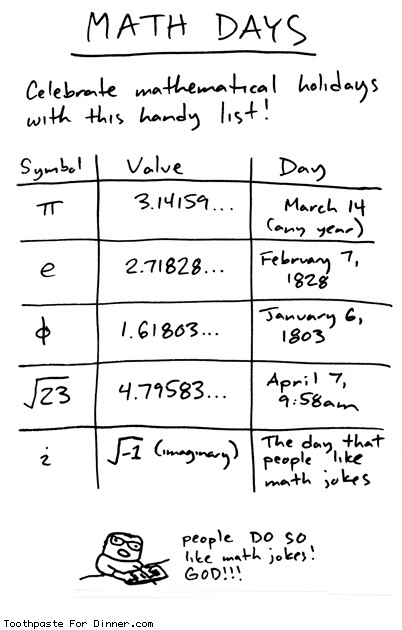Here are some math days to celebrate!
- Pi Day
Pi is a ratio between the diameter and circumference of a circle.
March 14th is the date set for this event, with 3.14 representing the first three numbers of an endless sequence of integers representing Pi.
- Pythagorean Theorem Days
The Pythagorean theorem states that the hypotenuse of a right triangle can be calculated using the formula a2 + b2 = c2.
To mark the significance of this revolutionary discovery, Pythagorean Theorem Day is celebrated on days that align with the formula.
As of November 2020, the last such holiday was on the 15th of August, 2017.
The numbers 82 + 152 = 172 represent a Pythagorean triple.
The next date for this celebration is December 16, 2020,
when 122 + 162 = 202.
There are 8 Pythagorean Theorem Days each century.
Click here for a list of all the Pythagorean Theorem Days in a century
- World Maths Day
The purpose of World Maths Day is to nurture the interest in mathematics as a science and to encourage people to be part of mathematics-related fields.
It is a world-wide math competition. The first World Maths Day was held on March 14, 2007 (Pi Day), and has been held on the 1st Wednesday in March in subsequent years.
- National Mathematics Day (India)
Srinivasa Ramanujan was a famous mathematician of Indian origin who was born on 22nd December in 1887. He was the subject of the 2015 film, The Man Who Knew Infinity. To celebrate his life and contribution to mathematics, December 22nd was declared National Mathematics Day by Dr. Manmohan Singh in February 2012.
- Fibonacci Day
On this holiday, we celebrate the Fibonacci sequence. The Fibonacci sequence is a series of numbers where any number is the sum of the two numbers preceding it. Here is the beginning of the series:
1, 1, 2, 3, 5, 8, 13, 21, 34, 55, 89, ...
Interestingly, the ratio between each number fluctuates around the 'golden ratio' Phi which has its own holiday.
Fibonacci Day is on the 23rd of November (11, 23) as represented by the first four numbers on the sequence, beginning with 1.
Other Fibonacci Number Days occur when six digits of the Fibonacci Sequence form valid dates. For example,
August 13, '21 (8/13/21)
January 1, '23 (1/1/23)
May 8, '13 (5/8/13)
-
Phi Day
Phi day celebrates the 'golden ratio' which is approximately 1.618 denoted by the Greek letter phi. Artists love this ratio for paintings (long side to short side). The famous Mona Lisa painting uses the golden ratio in many ways. You will also find it in architecture, and throughout nature from sunflowers to nautilus shells.
It was last celebrated on 6 Jan 2018 (1/6/18). The next date that aligns is not for another hundred years, on 6 Jan 2118 (1/6/18).
- E-Day (Eulers Number)
E-Day gets its name from Euler’s number, which starts with 2.7182818459045... and goes on to infinity. This mathematics holiday is therefore celebrated on the 7th of February each year. But 2018 was extra special as it included the first four digits in the date – something that wont happen for another 100 years.
- Square Root Day
The only thing square about Square Root Day is the date.
When the day and the month are both the square root of the last two digits of the year, we have a Square Root Day.
April 4, 2016 (4/4/16) was a Square Root Day, but the next one won’t be until May 5, 2025 (5/5/25)!
- Odd Day
Odd day is a day that singles out those wacky odd numbers.
It occurs when three consecutive odd numbers make up a date -- something that happens only six times a century. An example of odd day is 9/11/13. Enjoy Odd Day by being odd.
- Powers of Ten Day
It was celebrated on 10/10/10 and isn’t due to come around again for quite some time, so if you missed your chance to celebrate in 2010, you likely won’t live to see this holiday come round again.
- Palindrome Day
02/02/2020 -- the first global palindrome day in over 900 years.
The date is a palindrome, meaning it is the same when read forwards and backwards.
February 2, 2020, or 02/02/2020, in both the MM/DD/YYYY format and the DD/MM/YYYY format.
At just after 2 a.m., it was 02:02:20 on 02/02/2020.
This is the only time such a date will occur this century.
The previous palindrome date in all formats came 909 years ago on 11/11/1111. The next will come in 101 years on 12/12/2121
There are a total of 38 palidrome dates in the 21st Century, in the month/day/year date format as calculated by Aziz Inan.
Here are some examples:
January 20, 2021 (1202021)
December 2, 2021 (12022021)
February 20, 2022 (2202022)
March 20, 2023 (3202023)
April 20, 2024 (4202024)
May 20, 2025 (5202025)
June 20, 2026 (6202026)
July 20, 2027 (7202027)
August 20, 2028 (8202028)
September 20, 2029 (9202029)
March 2, 2030 (03022030)
- Multiplication Days
Multiplication Days occur when the month, day, and last 2 digits of the year form a multiplication equation.
7/14/98 7 x 14 = 98
11/9/99 11 x 9 - 99
4/5/20 4 x 5 = 20
3/7/21 3 x 7 = 21
- Other interesting Math Days
11/11/11 -- all the same digit (Only happens once in a century)
12/13/14 -- three consecutive integers in a row (also 11/12/13, 10/11/12, and others).
11/13/17 -- three consecutive Primes (also 7/11/13)
1/27 -- Mersenne Primes (the 4th such prime: 27 - 1 = 127)
2/22/22 (February 22, 2022) falls on a Tuesday so we will be able to call it 2's day which is really keeping me going man.
